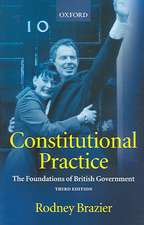Power, Politics, and the Decline of the Civil Rights Movement: A Fragile Coalition, 1967–1973
Autor Christopher P. Lehmanen Limba Engleză Hardback – 28 iul 2014 – vârsta până la 17 ani
Preț: 371.13 lei
Preț vechi: 483.69 lei
-23% Nou
Puncte Express: 557
Preț estimativ în valută:
71.04€ • 77.19$ • 59.71£
71.04€ • 77.19$ • 59.71£
Carte tipărită la comandă
Livrare economică 21 aprilie-05 mai
Preluare comenzi: 021 569.72.76
Specificații
ISBN-13: 9781440832659
ISBN-10: 144083265X
Pagini: 424
Dimensiuni: 156 x 235 x 30 mm
Greutate: 0.84 kg
Editura: Bloomsbury Publishing
Colecția Praeger
Locul publicării:New York, United States
ISBN-10: 144083265X
Pagini: 424
Dimensiuni: 156 x 235 x 30 mm
Greutate: 0.84 kg
Editura: Bloomsbury Publishing
Colecția Praeger
Locul publicării:New York, United States
Caracteristici
Identifies the instances in which the civil rights groups acted as a united coalition between 1967 and 1973 and recognizes how disagreements on separatism, feminism, and political campaigning split the Civil Rights Movement into individual civil rights groups
Notă biografică
Christopher P. Lehman, PhD, is professor of ethnic studies at St. Cloud State University, St. Cloud, MN.
Cuprins
AcknowledgmentsIntroduction: Old and New MovementsChapter 1 Violence Is NecessaryChapter 2 Open SeasonChapter 3 Shocked and SaddenedChapter 4 Facing AnnihilationChapter 5 A Hanging JudgeChapter 6 ManifestoChapter 7 No Peace in This LandChapter 8 Heads-Up MurderChapter 9 Times Have ChangedChapter 10 The Revolutionary ArmyChapter 11 Same Old ThingChapter 12 Run by DictatorsChapter 13 Explode All over the LandscapeChapter 14 Nation TimeChapter 15 Groovin' on DemocracyChapter 16 Their Most Vulnerable, Hopeless PositionChapter 17 Kicking the Blacks AroundChapter 18 The Movement of the SeventiesEpilogue: Leaders without a MovementNotesBibliographyIndex
Recenzii
This work should be required reading for anyone interested in the history of the civil rights movement. Summing Up: Highly recommended. All levels/libraries.
Lehman's book is an essential reference for those who want to understand how the movement functioned (and dysfunctioned) to create the pressures that resulted in eliminating much of the terrorism facing blacks in the South, and how it provided blacks with a sense that change is possible.
This study provides an engaging and much-needed narrative of the fate of national Civil Rights organisations in the later years of the movement. There is compelling analysis of the inter-organisational relationships and conflicts of SNCC, SCLC and other Civil Rights organisations, and interesting insights into the complex and inter-connected factors that contributed to the decline of these organisations.
Lehman's book is an essential reference for those who want to understand how the movement functioned (and dysfunctioned) to create the pressures that resulted in eliminating much of the terrorism facing blacks in the South, and how it provided blacks with a sense that change is possible.
This study provides an engaging and much-needed narrative of the fate of national Civil Rights organisations in the later years of the movement. There is compelling analysis of the inter-organisational relationships and conflicts of SNCC, SCLC and other Civil Rights organisations, and interesting insights into the complex and inter-connected factors that contributed to the decline of these organisations.












